Oregon vs Colorado: A prehistoric series, part III
Sept 23, 1967: Colorado 17, Oregon 13
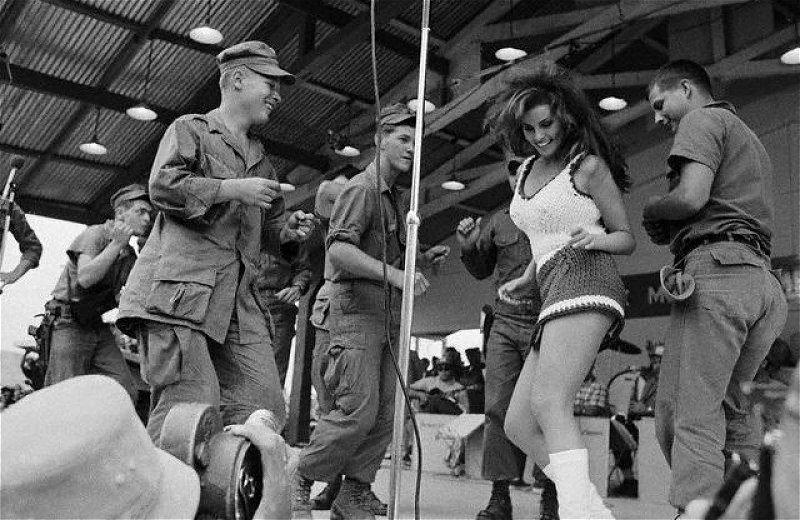 Raquel Welch, shaking it in a knit mini for troops at a USO show, Oct 1967 (AP)
Raquel Welch, shaking it in a knit mini for troops at a USO show, Oct 1967 (AP)
44 years ago, the run-up to the Oregon-Colorado game was similar in some ways to this year. There was a Romney running for president; George Romney, Michigan governor and father of current candidate Mitt, who – as the AP put it – “made the scene in hippieville and [has] given scores of hippies a temperance lecture” during a visit to San Francisco. The country was mired in an unpopular war; in 1967, the antiwar sentiment hadn’t yet boiled over, but it was simmering, under headlines like “B52s Attempt To Still Fire By Commies.” But celebrities were still lining up to appear in USO shows hosted by Bob Hope, even as the NVA was being McNamara’d into submission.
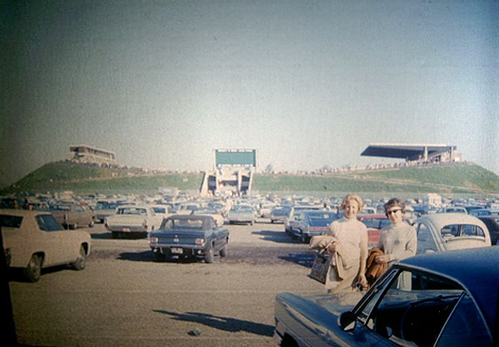 Opening Day tailgaters (source unknown)
Opening Day tailgaters (source unknown)
Eugene hadn’t quite yet become hippie central, and the big local story in early September 1967 was the new home of the Ducks. Like the last televised Oregon home game, the opponent was Colorado. Selected for an ABC regional broadcast, to celebrate the opening of the very recently finished Autzen Stadium, the crowd was better than expected, but still, only 27,500 showed up for the season opener; commentators blamed the good weather, opening day of hunting season, the AL pennant race and the fact the game was televised. The ticket prices probably weren’t keeping fans away – reserved seats went for $5 and kids got in for 50 cents. (Autzen wouldn’t sell its first SRO tickets until the 1969 Civil War).
Among the non-attending: members of ABC’s broadcast team, including a young Keith Jackson, who stayed away in solidarity with a television engineer’s union strike — or perhaps because he would have been fined $25,000 by his union if he crossed the picket line. The game was called by ABC management employee Ken Flowers, flown up at the last minute from LA, joined by former coach and new Oregon AD Len Casanova and Colorado AD Dallas Ward, which must have been interesting considering the lack of broadcast experience by both parties. One press box veteran said Cas was so nervous “he looked like he was about to play Washington for the national championship.” And, in an era when color television had become all but ubiquitous, the game was broadcast in black and white, thanks to the strike; it would be the last ABC game to appear in monochrome.

The probation of ‘62 had hit Colorado hard. New coach Bud Davis inherited a mess, and left one, after losing 24 players to grades and suspension and one 2-8 season. In came Eddie Crowder, who was at least given time to right the ship; after successive 2-8 seasons, Crowder’s charges went 6-2-2, then 7-3 (but just five points from 9-1), and by 1967 were the consensus pick to win the Big Eight.
“Easy Ed” Crowder, an all-American at quarterback in the early 50s for Bud Wilkinson’s powerful Oklahoma squad, ran an old-school offense: Line ‘em up and ram it down their throats via the option.
We’re trying to play tough football.. it’s difficult, when things are going bad, to stay away from gimmicks. But we will avoid gimmicks, maintain tough football and eventually it will pay off… We prefer a four-yards-per-play offense. That’s the basis of our beliefs. We play the percentages, like to power the football in a ball-control show.”
Crowder brought a veteran club to Eugene, with eleven senior starters to just four for Oregon. Coming off a 20 point win over Baylor, the ninth-ranked Buffs were solid favorites. But Crowder worried about his 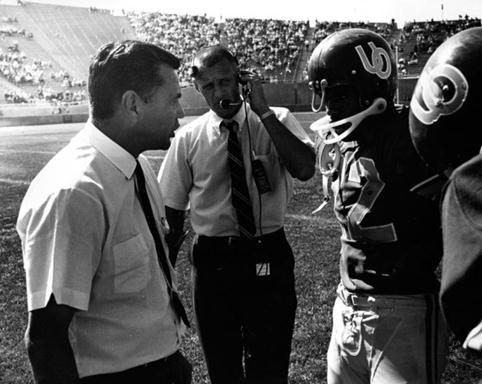 Assistant Max Coley, HC Jerry Frei, and HB Claxton Welch (UO Archives)secondary. “The Ducks have marvelous receivers and throwers, and this concerns us the most, because we have had some poor afternoons on pass defense.”
Assistant Max Coley, HC Jerry Frei, and HB Claxton Welch (UO Archives)secondary. “The Ducks have marvelous receivers and throwers, and this concerns us the most, because we have had some poor afternoons on pass defense.”
Crowder had injury problems. Wilmer Cooks, his all-Big-Eight fullback from 1966, had missed the Baylor contest and was unlikely to play in Eugene. Both of his defensive end starters sprained their ankles against the Bears. Still, it was thought there would be enough firepower to take care of the Ducks, and oddsmakers set the Buffs as 21-point favorites.
Crowder’s secret weapon, sophomore Bobby Anderson, had been named Big 8 Back of the Week after tallying three TDs at Baylor; it was the biggest day for a first-time player in the conference in at least 30 years. (Like a certain Oregon quarterback of the modern age, Anderson had been recruited by other schools, but told his future was as an “athlete”; Crowder saw him as a prototype option QB, and sold the young native of Boulder on his hometown team.)
Anderson led his Colorado teammates onto a brand-new stadium with freshly laid grass and plenty of empty seats on a blistering hot day against a team with a new head coach, a great tactician without a lot of talent. New Oregon head coach Jerry Frei had already seen his team, now known as the “Fighting Ducks” after the Webfoots moniker had been semi-officially retired, blow a 4th-quarter lead in a 21-13 loss at Berkeley, after Eric Olson had thrown a late pick-6 to Cal’s Irby Augustine. Olson had replaced highly touted soph Tom Blanchard after an ankle sprain; Frei wanted a wide-open game, primarily because he knew his running attack was limited, but Blanchard was the more mobile signal caller.. when he wasn’t hobbled.
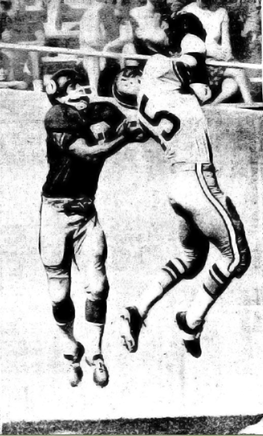 Colorado DB Chuck Greer picks off pass intended for Oregon’s Scott Cress, one of six INTs by the Buffaloes. (AP Photo)The Ducks were small up front and inexperienced in the backfield, and had only eked out 23 yards rushing against Cal (for the season, they would average under 95 yards a game on the ground, and barely 2.3 yards per carry), despite having a halfback with one of the coolest names in Oregon football history, Claxton Welch.
Colorado DB Chuck Greer picks off pass intended for Oregon’s Scott Cress, one of six INTs by the Buffaloes. (AP Photo)The Ducks were small up front and inexperienced in the backfield, and had only eked out 23 yards rushing against Cal (for the season, they would average under 95 yards a game on the ground, and barely 2.3 yards per carry), despite having a halfback with one of the coolest names in Oregon football history, Claxton Welch.
But they could throw a little, with Olson, Blanchard, and John Harrington – father of you-know-who – capable of slinging the ball around. Against Colorado, the ball was slung around wildly, to the tune of nine turnovers – six INTs and three fumbles – and you’d think it would have been a rout.. but you’d be wrong.
Colorado raced out to an early 14-0 lead behind the multi-talented Anderson, who ran for one 18 yard TD and threw 58 yards to Mike Pruett for another. The second TD came after an unexpected gift – on a 4th-and-17 situation at the Colorado 35, Olson saw the scoreboard clock read 11 seconds remaining in the half, and hurried the team into a broken play, turning the ball over on downs. But the clock had malfunctioned; the time should have read 8:11. So much for home field advantage.
After allowing an early field goal, Oregon’s defense stepped up big time in the 2nd half. Led by all-conference DB Jim “Yazoo” Smith and All-Coast lineman George Dames, the Ducks limited Colorado to 261 yards, with only 75 of those after halftime; the Buffs were in the red zone four times and got no points for their trouble. And, despite all the picks, Oregon’s QB-by-committee offense rolled up 301 yards passing, a team record.
Still, the anemic Oregon offense couldn’t cash the checks a stellar defense was writing, and the Ducks had two red-zone failures of their own. The 13-17 “moral victory” was one of eight losses for Frei’s young Ducks on the season.
Frei was proud of his players.
None of ‘em lost the faith.. they didn’t believe Colorado was better than they were.. I’m pretty proud of those guys. We’re gonna go on from here.”
And the new stadium? Fans gave it generally high marks, especially in comparison to the ancient and cramped facility called Hayward Field that it had replaced.
There were issues. The aforementioned stadium clock ran continuously for the first five minutes of the second half; six Colorado plays, two first downs and a field goal attempt somehow ate up 4:03 on the clock, a fact noted by sportswriters but nobody important. The concession stands ran out of soft drinks halfway through the third quarter. There weren’t enough “facilities.” Several fans collapsed from the heat – the only shade in the facility was under the cover of the sponsor’s section, where riot squads disguised as Boy Scout ushers worked frantically to keep parched desperate fans out of the money 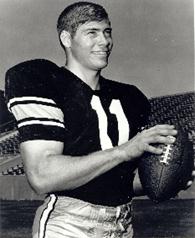 Colorado QB Bobby Anderson, 1967zone.
Colorado QB Bobby Anderson, 1967zone.
Oregon would go on to suffer three consecutive shutout defeats, against Utah, Ohio State and Washington, before getting that first Autzen victory over Idaho. Despite only gaining 510 yards that season – 138 of those against Wazzu — Claxton Welch earned enough respect at halfback to be named to the Pac-8 all-conference 2nd team (behind O.J. Simpson and OSU’s Bill Enyart).
Bobby Anderson carried Colorado in 1967 to a 9-2 record and a Bluebonnet Bowl victory over Miami, leading the team in both rushing and passing. Denver drafted him #1 in 1970, and he played in the NFL for six years. Anderson was inducted into the College Football Hall of Fame in 1996; he is a longtime member of the CU Football Network broadcast team.
 oregon football history in
oregon football history in  1960s,
1960s,  1967,
1967,  Oregon vs Colorado
Oregon vs Colorado 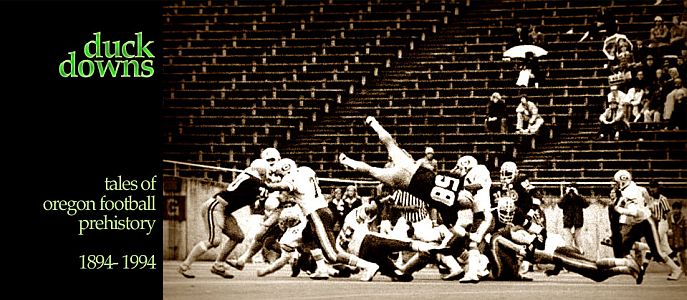
Reader Comments (1)
Benz,
You are the Rose Bowl of Duck Fans. We are forever in your debt.